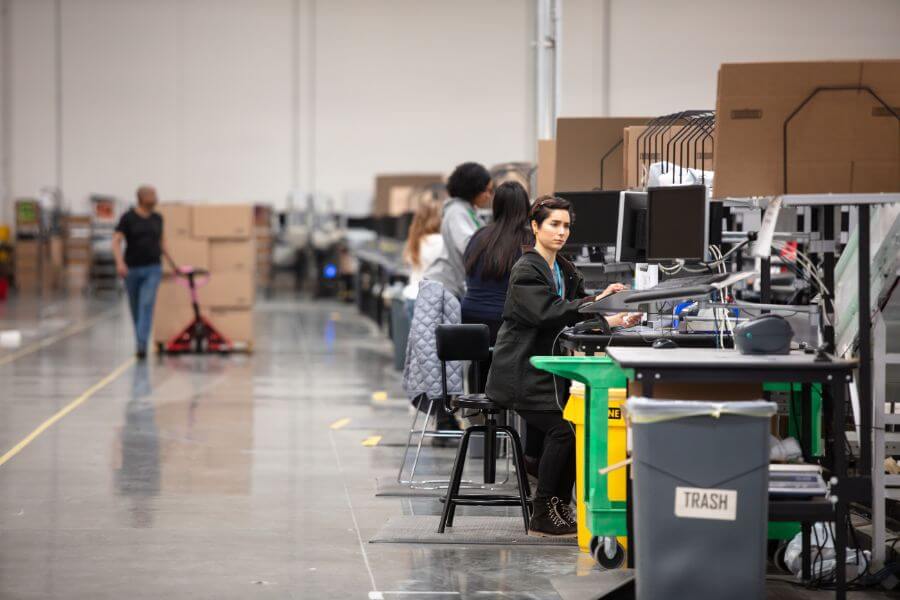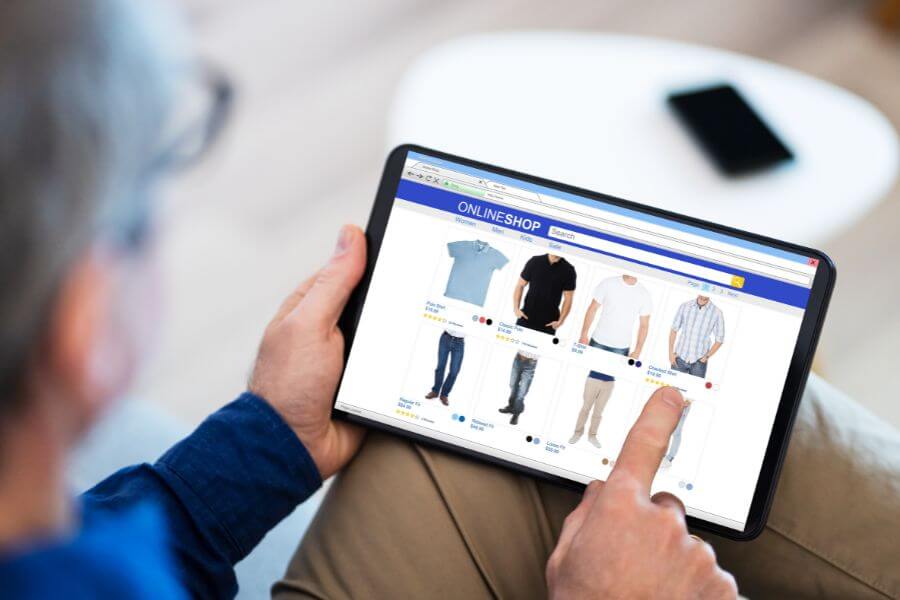Order delivery and fulfillment costs take center stage in online retail, holding the strings to a retailer’s profitability. A recent paper in the European Journal of Operational Research shed light on the impact of fulfillment strategies. The verdict? Fulfillment from distribution centers or direct-to-consumer fulfillment centers emerges as the profitability champion, while store-based fulfillment grapples with higher costs, all thanks to higher wages for store employees.
In this blog, we’ll uncover insights into direct fulfillment processes, from order processing to last-mile delivery, and uncover how it’s working its way into the heart of retail.
What Exactly is Direct Fulfillment?
Direct-to-consumer (D2C) sales are making waves in the retail landscape. According to Statista, established U.S. brands are on track to surpass $134 billion in D2C sales by 2023, with a projected jump to about $186 billion by 2025. Additionally, digitally native brands are expected to contribute nearly $35 billion in D2C e-commerce sales in 2023.
Now, let’s dive into the basics of direct fulfillment:
Direct fulfillment is a smart supply chain strategy where products go straight from the manufacturer or distributor to the end customer. This skips the traditional retail route, streamlining the journey from production to the customer’s doorstep. Essentially, it cuts out the middlemen, often leveraging e-commerce platforms to make the process efficient and direct.
How does the Direct Fulfillment Process Work?
Direct fulfillment strategies are designed to streamline the journey of products from the manufacturer or distributor directly to the end consumer. Here’s a simplified breakdown of how the process typically works:
1. Order Placement – The process begins when a customer places an order, often through an online platform or e-commerce website.
2. Order Processing – The order is received and processed in real-time, usually through an automated system. This involves checking the availability of the product in the inventory.
3. Inventory Management – Direct fulfillment relies on accurate and up-to-date inventory management. The system ensures that there is sufficient stock to fulfill the order.
4. Packaging – Once the order is confirmed, the product is picked from the inventory and prepared for shipping. It is then appropriately packaged for transit.
5. Shipping Label and Tracking – A shipping label is generated and the package is assigned a tracking number. This allows both the business and the customer to monitor the shipment’s progress.
6. Shipping – The packaged product is sent directly from the manufacturer or a designated fulfillment center to the customer’s address. This skips the traditional retail distribution channels.
7. Customer Interaction – Direct fulfillment emphasizes direct communication with the customer. The brand handles inquiries, feedback, and concerns, fostering a closer relationship.
8. Delivery to Customer – The product reaches the customer’s doorstep, completing the direct fulfillment cycle. This direct-to-consumer model aims to reduce transit times and enhance overall customer satisfaction.
How does Direct Fulfillment Benefit your Business?
Direct fulfillment is a game-changer for businesses, offering a range of specific benefits that directly impact efficiency, cost-effectiveness, and overall customer satisfaction.
Streamlining Operations
Here’s how direct fulfillment works. Instead of following the traditional route through a retailer, products take a shortcut, going directly from the manufacturer or distributor to you, the end consumer. This clever bypass not only shortens the journey but also gives businesses more control over everything – from making the product to getting it to your doorstep. By eliminating the retailer from the equation, businesses can fine-tune the entire process. They have a direct line from the creation of the product to its final delivery, allowing for smoother operations and increased efficiency.
Mastering Product Dynamics
Think of direct fulfillment as the control center for real-time updates to your product listings. This means instantaneous adjustments to keep your offerings in lockstep with the latest market trends. Businesses can manipulate their product lineup, swiftly adapting to market shifts or strategic decisions. A standout technical feature of direct fulfillment is its real-time inventory management. This isn’t just about keeping tabs on stock levels; it’s a live, detailed view that prevents logistical bottlenecks. Businesses benefit from data-driven decision-making, ensuring that their product offerings are not only well-timed but also finely tuned to meet the demands of the current market.
Speed Redefined
Direct fulfillment stands out for its rapid product delivery, ensuring a swift journey from the manufacturer to the consumer. By sidestepping traditional retail channels, the process becomes more straightforward, leading to faster order processing and shorter transit times. This heightened efficiency directly translates to increased customer satisfaction and a boost in customer loyalty. However, even if there are occasional delays in shipments, direct fulfillment trends suggest that D2C (Direct-to-Consumer) customers are surprisingly understanding. In cases where congestion at ports causes delays, a 2022 survey indicates that nearly half of US shoppers are willing to wait anywhere from three to five days for their D2C purchases. More surprisingly, over 20% are patient enough to wait up to eight days.
Diversification Made Simple
Direct fulfillment allows you to increase your Stock Keeping Units (SKUs) – the different products you offer. By simplifying and making your supply chain more cost-effective, direct fulfillment paves the way for your business to diversify its product range. Imagine your business as a shop with more items on the shelf. That’s the effect direct fulfillment has. It’s not just about the number of products; it’s about strategically offering a broader selection. This streamlined approach to supply chain management allows businesses to cater to a larger audience without the complications often associated with expansion.
The Financial Edge
Direct fulfillment brings a financial win for businesses by streamlining operations and slashing unnecessary expenses. The removal of intermediaries is at the heart of this efficiency, directly impacting:
Cutting Out Intermediaries – By connecting manufacturers directly to consumers, businesses avoid the additional costs associated with middlemen, reducing expenses right from the start.
Warehousing Expenses – With a more direct route from production to consumer, businesses can optimize their warehousing strategies. This means reduced storage costs, as the streamlined process minimizes the time and space products spend in warehouses.
Distribution Costs – Direct fulfillment shortens the distribution chain, cutting down on transportation and logistics expenses. By having a more direct route, businesses save on fuel, shipping fees, and other costs related to the traditional distribution process.
Inventory Management – The streamlined approach of direct fulfillment enables businesses to manage inventory more efficiently. With real-time insights and reduced handling, businesses can minimize the costs associated with excess inventory and stockouts.
Reduced Fees – Traditional retail models often come with various fees, including those charged by retailers and distributors. Direct fulfillment minimizes or eliminates these fees, contributing to significant cost savings for businesses.
Why 3PL Partnerhips Shine in Direct Fulfillment
According to a 2022 survey, 88% of consumers are willing to pay extra for same-day delivery, and 62% consider it a key factor in their purchase decisions. Moreover, a staggering 53% of consumers abandoned their purchase due to excessively long shipping times.
These statistics highlight the critical role of last-mile delivery in businesses providing direct fulfillment.
Navigating this last mile in the direct fulfillment journey demands precision, and businesses find a reliable partner in a 3PL company like Simple Global. Here’s how this collaboration can benefit your business.
1. Localized Efficiency – 3PL companies excel in localized logistics, leveraging their knowledge of specific regions for efficient last-mile delivery. Whether it’s optimizing routes in urban landscapes or navigating rural areas, their expertise ensures packages reach their destinations swiftly, overcoming local challenges seamlessly.
2. Dynamic Route Optimization – The last mile is all about the final stretch, and 3PL partners bring advanced route optimization strategies. Using real-time data and analytics, they can dynamically adjust delivery routes, reducing transit times and enhancing the overall efficiency of the last-mile process. This dynamic approach is crucial for meeting customer expectations for quick deliveries.
3. Technology Integration – 3PL companies invest in cutting-edge technology to enhance last-mile delivery. From GPS tracking to route planning software, businesses partnering with 3PL providers can leverage these technologies for real-time visibility into the delivery process. This not only improves operational transparency but also allows businesses to provide customers with accurate delivery updates.
4. Scalable Operations – Direct fulfillment often involves fluctuating demand, and 3PL partners offer scalability. During peak seasons or sudden surges in orders, businesses can tap into the resources and network of their 3PL partner to scale up last-mile delivery operations without the need for significant internal adjustments.
5. Cost-Efficient Last Mile – Beyond expertise, 3PL partnerships bring cost efficiency to the last-mile delivery stage. Consolidated resources, shared delivery routes, and economies of scale allow businesses to control last-mile costs effectively.
Conclusion
When more than half of consumers abandon their carts due to slow shipping, and almost 90% are willing to pay extra for same-day delivery, the last mile isn’t just a distance; it’s a game-changer.
Adapting efficient direct fulfillment practices is the answer, but it’s not just about reaching the destination. It’s about understanding that every step in the journey matters. From cutting out unnecessary stops to partnering with experts like Simple Global, it’s a strategy that aligns with what today’s customers demand – swift, reliable, and hassle-free experiences.
If you’re ready to transform your direct fulfillment strategy and keep your customers not just satisfied but delighted, Simple Global is here for you. Let’s navigate this journey together and redefine the standards of customer experience!





